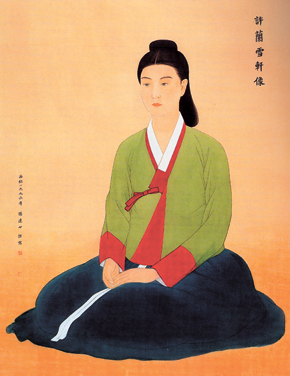Heo Nanseolheon facts for kids
| Heo Nanseolheon | |

Portrait of Heo Nanseolheon
|
|
Quick facts for kids Korean name |
|
|---|---|
| Hangul | |
| Hanja | |
| Revised Romanization | Heo Chohui |
| McCune–Reischauer | Hŏ Ch'ohŭi |
| Art name | |
| Hangul | |
| Hanja | |
| Revised Romanization | Heo Nanseolheon |
| McCune–Reischauer | Hŏ Nansŏrhŏn |
Heo Nanseolheon (1563 – 19 March 1589) was an amazing Korean painter and poet from the mid-Joseon dynasty period. She was the younger sister of Heo Bong, who was a politician and writer. She was also the older sister of Heo Gyun, a famous writer who wrote The Tale of Hong Gildong. Heo Nanseolheon wrote about 200 poems in Chinese style (called hanshi). She also wrote two poems in hangul, the Korean alphabet, though some people aren't sure if she wrote those two.
Contents
Her Life Story
Growing Up as Heo Cho-hui
Before she was known as Heo Nanseolheon, her name was Heo Cho-hui (허초희, 許楚姬). She was born in Gangneung into a very important political family. Her father, Heo Yeop, was a respected scholar. Even though her father believed that men were more important than women, her older brother, Heo Bong, saw her talent. He helped her learn about literature and writing.
From a young age, Heo Cho-hui was known as a very gifted poet. When she was only eight, she wrote a poem called "Inscriptions on the Ridge Pole of the White Jade Pavilion in the Kwanghan Palace." People loved it so much that they called her an "immortal maiden." Her brother Heo Bong taught her Chinese writing and classic books.
Heo Bong was also a strong political thinker. He was sent away to a place called Kapsan for three years because of his political views. Her younger brother, Heo Gyun, was also a talented poet. He studied with Yi Tal, who was an expert in Tang poetry. Heo Gyun helped Heo Cho-hui with her education, especially after their older brother was exiled. Yi Tal also shared Tang poetry with her, which influenced her writing style.
Her Marriage and Challenges
Heo Cho-hui married Kim Seong-rip, the son of a government official. Sadly, her marriage was not a happy one. Her husband often left her alone to spend time with other women. She also had a difficult relationship with her mother-in-law.
She had two children, a girl and a boy. Both of her children died very young, which was a great sorrow for her. Not long after her older brother Heo Bong passed away, Heo Nanseolheon herself died from an illness. She was only twenty-seven years old.
Some experts believe that she lived with her brothers for a long time before getting married. They think she wrote many of her nature-themed poems during that time. After she married, her poems often showed sadness and the difficulties faced by married women. This is because she felt lonely and cut off from her literary friends.
Her Family
Heo Nanseolheon came from a large and important family. Here are some of her close relatives:
- Father: Heo Yeob (허엽, 許曄) (1517 - 1580)
- Mother: Lady Kim of the Gangneung Kim clan
- Stepmother: Lady Han of the Cheongju Han clan
- Older half-brother: Heo Seong (허성, 許筬) (1548 - 1612)
- Older brother: Heo Bong (허봉, 許篈) (1551 - 1588)
- Younger brother: Heo Gyun (허균, 許筠) (1569 - 1618)
- Husband: Kim Seong-rib (김성립, 金誠立) (1562 - 1592)
- Children:
- A son, Kim Hui-yun, who died young.
- A daughter, who also died young.
Her Writings
Heo Nanseolheon asked for most of her writings to be burned after she died. Luckily, some of her poems were saved and collected in a book called Nansŏrhŏn chip in 1913. This collection has 211 poems written in different Chinese styles.
In her time, most "serious" writing in Korea was done in Chinese. Writing in hangul was not seen as important for deep thoughts. However, Heo Nanseolheon's poems are special because they cover many different topics. This is partly because her marriage changed her feelings and experiences a lot.
There are two poems in the collection written in hangul. Some scholars debate if she actually wrote them. The titles of these hangul poems are similar to two of her confirmed Chinese poems. However, recent studies have questioned if she truly wrote them.
Famous Poems
Here are some examples of Heo Nanseolheon's beautiful poems:
"Song of Autumn Night"
This poem shows her earlier style, which was full of imagination and vivid pictures.
|
秋夜曲 |
"Song of Autumn Night" |
| —Heo Nanseolheon | —Translated by Kuiwon |
"The Young Seamstress"
This poem shows her sympathy for people who were not rich.
|
貧女吟 |
"The Young Seamstress" |
| —Heo Nanseolheon | —Translated by David R. McCann |
"Woman's Grievance"
This poem shows the sad feelings she had after her marriage.
|
閨怨 |
"Woman's Grievance" |
| —Heo Nanseolheon | —Translated by Yang-hi Cheo-Wall |
Works
- Nanseolheon jip
- Chwesawonchang
Images for kids
See also
 In Spanish: Heo Nanseonheon para niños
In Spanish: Heo Nanseonheon para niños






